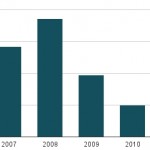Idaho Labor Department Braces For $3.5 Million Funding Cut

Chris Hondros / Getty Images
A job-seeker browses job listings at an employment office. In Idaho, at least 50,800 people are unemployed.
The state agency that handles unemployment insurance benefits, workforce training and helps jobless Idahoans search for work, anticipates a $3.5 million budget cut beginning at the stroke of midnight.
It’s the sequester, the $85 billion in automatic, across-the-board federal spending cuts that have the potential to affect nearly every aspect of government services. The Idaho Department of Labor is no exception — the agency charged with helping people find employment will now find itself cutting jobs.
Chief deputy director John McAllister has been through these kinds of cuts and swings in funding before. He’s been at the Idaho Department of Labor for 40 years and watched funding fluctuate dramatically in the 1980s, 90s, 2004, and the most recent recession.
“Our budget really follows the business cycle,” McAllister says. “When there is a recession we get a lot of federal money, and usually before the recovery has happened our funding drops off significantly. We have fairly drastic swings in our staffing levels.”
This time around, he’s planning for a 15 percent reduction in temporary, part-time, and seasonal employees. Full-time workers won’t be furloughed or laid-off, McAllister says.
The Idaho Labor Department currently has about 670 full-time employees, there are more than 700 when counting temporary and part-time workers. In 2004, McAllister says the department cut 15 to 20 percent of its staff. This time around, he’s planning for a 15 percent reduction in temporary, part-time, and seasonal employees. Full-time workers won’t be furloughed or laid-off, McAllister says.
If they do see their jobs evaporate, those temp workers will likely end up on the other side of the unemployment benefit counter, as many of them will be eligible for weekly jobless benefits. McAllister says processing those insurance benefit claims will likely take longer.
“They’ll have to wait in line with everybody else,” he adds.
At last count, there were at least 50,800 Idahoans out of work. That’s 6.6 percent of the state’s workforce. Many jobless Idahoans are eligible to receive unemployment benefits. The state pays for a maximum of 26 weeks. Some unemployed workers are eligible for extended benefits, which are paid for by the federal government. Those federal extended benefit payments are expected to decrease by 10 percent under sequestration.
The Labor Department’s $3.5 million anticipated funding reduction won’t happen all at once or overnight. Assuming a deal isn’t reached to avert sequestration, the Labor Department will spread that 10 percent budget cut across the next year.
McAllister says all services, including jobless benefits and job search assistance, won’t be as timely. “It’s likely to have some impact on our service delivery, but it’s not the end of the world, it’s an inconvenience for our customers and will put our employees under a lot of stress too.”
McAllister says he’d rather avoid the sequester cuts, but is prepared for it nonetheless.
“We’re not real happy it’s going to happen, if it happens, but we’re prepared to deal with it,” he says. “It won’t be fun. It’s going to be a difficult endeavor. It’d be nice if the Congress and the president had an alternative.”

